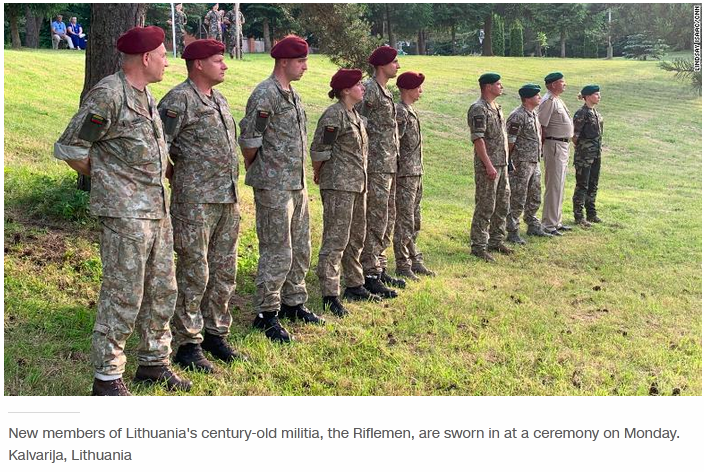Vytas Grudzinskas, a 59-year-old businessman, will frequently be awake during the night due to the neighborhood being close to the likes of Russia; meaning he is generally deprived of rest at night. “I can see the soldiers best at night,” he says, pointing to a patch of green behind his neighbor’s garden. “They have a shooting range in this area behind that patch of grass. In the early afternoon, you can hear the gunfire,” he said.
Grudzinskas’s weapon of choice is a machine gun, which he keeps locked in a cupboard. Although it wouldn’t be much use for battle, Grudzinskas’s other security measure might be more effective: his guard dog, a Maltese terrier. The small city of Kybartai–located along the Suwalki corridor–lies inside both NATO and the European Union but also along one of the world’s hottest borders: Russia’s heavily fortified, nuclear-armed Baltic bolthole of Kaliningrad and its ally, Belarus. This tract of land–which stretches about 60 miles wide–is sandwiched between Kremlin troops who could invade at any moment. Many analysts view it as a weak point within NATO; if Ukraine fell, Russia would advance through it next and cut off the Baltic states in days.
A legacy of Soviet occupation deeply impacts this region of Europe. Countless Lithuanians were unlawfully expelled to gulags in Siberia and the Arctic in response to the Soviets’ fascist union. More than 30,000 Lithuanian prisoners perished in the mass camps during the deportations.
Grudzinskas’ father was sent to Sakhalin, Russia’s far westernmost point, where he survived on grass for the first year. In 2014, Russia annexed Crimea. Grudzinskas joined Lithuania’s century-old volunteer militia—the Riflemen—and took up arms in his own backyard. That means he is the first line of defense if the Kremlin’s troops stationed 60 feet away in the Russian exclave put one foot on NATO territory. “How can you trust Russia? With our history?” he asked. “Of course, I’m scared. How could I not be?” he added. “My family is here. I built this house with my bare hands.”
According to the commanding officer of the Riflemen’s 4th Regional Command, the 103-year-old volunteer militia—which was formed during World War I—has seen its numbers balloon since Russia invaded Ukraine in February. Currently there are about 12,000 volunteer members; however, that number is increasing each month by an average of 10 times. Since the first days of the Ukraine war, the number of new recruits seeking to join each month has risen from 10 to 12 to more than 100.
In his native city of Marijampole, deep in the Suwalki corridor, Papeckys holds up some of his arsenal at his headquarters. The 51-year-old is also trying his best to stay clear of a return to the old Russian regime. His father was sent to Siberia, as was his wife’s family.
We want to stay out of the Soviet occupation, and we don’t want to be occupied anymore. We’re independent individuals, said Papeckys.
A Riflemen organization was established in the neighboring city of Kalvarija on the 103rd anniversary of the foundation of the organization. New member Karolis Baranauskas says he was always interested in the organization but that the war in Ukraine called him to action. Although he was born in 1990, the year Lithuania became independent from the Soviet Union, he says that “every Lithuanian knows that Russia is a threat. The recent events prove that.” To better protect the Baltics, NATO has radically overhauled its defense planning in this part of the world, announcing ahead of a summit in Madrid this week that it would increase its presence in the region enough to repel any attack in real time, rather than sending in troops to recapture territory once it’s been seized. That will mean thousands more troops, which Lithuania would like to see based permanently around their 621-mile-long borders with Belarus and Russia.
Margiris Abukevicius, deputy defense minister of Lithuania, says it could take two years for additional troops to be in place at the Suwalki Gap, a historically vulnerable area between NATO allies Lithuania and Poland. But he says there is now an understanding that military capabilities need a substantial upgrade around Suwalki. The corridor, also known as the Suwalki Gap, has always been a cause of worry according to Abukevicius. It’s understood to be a “weak point” by the Baltics and NATO. “In the current situation we understand the vulnerability much clearer,” he told CNN in an interview on Tuesday at the Ministry of Defense in Vilnius, the capital. “I think NATO understands that and takes decisions,” he said. “I really hope that NATO’s summit this week will give a very strong response and a very clear direction where NATO’s long-term adaptation should go.”
Lithuania says it has been fending off ongoing Russian cyberattacks on its state institutions and private sector in recent days following its decision last week to block some goods like grain and steel — which are subject to EU sanctions — from being transported by train into Kaliningrad. Although cyberattacks by Russian hackers are relatively common in Lithuania, Lithuania’s State Security Department chief Viktor Abukevicius said that the blockade was the “trigger point.” During target practice at a shooting range nestled in the lush landscape of Marijampole, Grudzinskas and other members of Papeckys’ unit aim their assault rifles during target practice, just as the Russian soldiers behind Grudzinskas’ street often do. Their shots momentarily shatter the quiet, but for now the fragile peace holds.



